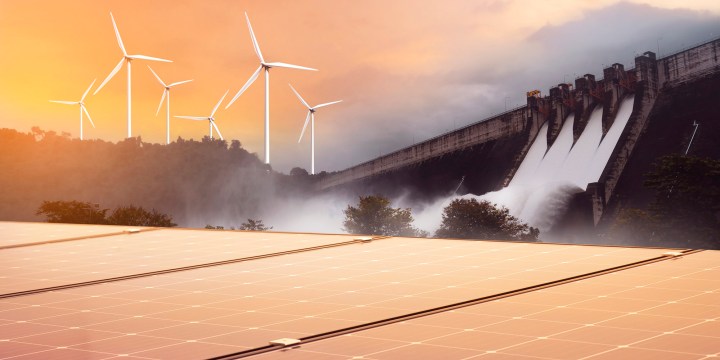BUSINESS REFLECTION
After the Bell: The way people misunderstand renewable power is shocking

I can’t get away from the feeling that the constant, relentless defence of coal has a larger agenda somewhere behind it.
How do we comprehend the resistance among key ANC senior members to environment-friendly energy sources? There are political reasons of course; the coal supply chain is now heavily dominated by businesspeople who have a huge incentive to keep coal front and centre of SA’s energy profile. But there is also a lot of resistance to solar and wind power among the cognoscenti generally, both inside and outside of the political realm. A good example is former Eskom CEO Jacob Maroga, who is on Twitter almost every day angrily arguing the case for coal.
For instance, his tweet on Monday, apropos of very little, that: “The German Energy Transition going very well. Powered by King Coal and Gas”. Alongside the tweet is a measure of German electricity consumption, which shows the power generated by coal at 30GW, and gas at about 17GW, with solar and wind at about 8GW combined. The “going very well” comment is obviously sarcastic.
It’s hard to know what this is supposed to prove; everybody knows that the world is still dependent on coal power. That’s exactly the core of the problem. Pointing out that “king coal” is still crucial strikes me as a bit of a straw man argument. Doubtless, there is value in making its contribution plain, but I can’t get away from the feeling that the constant, relentless defence of coal has a larger agenda somewhere behind it.
Neither are his objections without value; they are just so dated. Of course, renewable energy is variable; who doesn’t know that? Triumphantly, Maroga cites the fact that UK electricity prices have soared to record highs as solar and wind output has slumped. In a different tweet, he claims the UK national grid was powered 57% by fossil fuels and 7% by renewables. He claims installed wind capacity is 39GW “but only 1.47GW available”, citing the UK national grid’s live tracking website. A good example of “When the wind is not blowing & the sun is not shining”, he points out.
Yes, obviously. But the same data source produces a tally for different time periods and includes the average production for the year. That shows that wind in the UK has produced about 28% of the country’s energy needs on average through the year, generating about 8.5GW at any one time. That figure is just a click away. On the same website!
Visit Daily Maverick’s home page for more news, analysis and investigations
I’m not necessarily intending to single Moroga out; he is just a good example of conversations I had with many people who are enormously sceptical about renewable energy, often just out of a gut feeling rather than any data. At least Moroga is data-centric, if selectively. Sometimes, you sense that it is a broader political issue: renewable energy is one of those things those horrible woke people with their endless placards are constantly going on about. But us old owls know the truth; coal is king! Etc.
But there is a more important reason, I think: people generally have a poor understanding of just how fast renewable energy has developed over the last decade. There is a great article on the site Our World In Data on how and why that happened. The brief version is that circa 2009, the levelised cost of electricity from utility-scale solar photovoltaics cost $359 per MWh. The levelised costs include the costs of construction and the ongoing costs of production. It’s the fairest comparison of different electricity sources.
That cost has come down to now $40 per MWh, marginally cheaper than wind power. That change, therefore, occurred at a truly extraordinary pace, much, much faster than people’s guts generally tell them. The speed of change is a testament to the new speed of technological change that we see in all kinds of industries. The cycle of knowledge, the learning rate, and the production efficiency rate are all eye-watering in certain select industries in the modern era. Think of chip development and biogenetics. Inventions in some areas tend to compound on top of each other. Consequently, it is hard to truly appreciate the significance of this acceleration, so we tend to get caught in old mindsets very quickly.
And yet some don’t change. Over the same period, coal power’s cost has been flat, at around $109 per MWh, while the cost of nuclear power has risen by 26% to $155 per MWh. But why did coal power not experience the same acceleration of discovery? Mainly because it’s so old there is actually little room for improving the efficiency of coal power plants substantially, Max Roser, the founder of Our World in Data speculates. In addition, since the cost of coal power is so dependent on the price of coal, the chances it will get cheaper in the future are small.
So, the cost of solar energy is now a quarter of nuclear, and less than half that of coal. Be honest, did you know that? Of course, this doesn’t take into account all kinds of things Moroga rightly points out: energy variability, sunk costs, systems operation, wheeling, and all kinds of important technical issues. And it’s worth noting that gas power has become a lot cheaper over the past decade too.
But surely the utility of solar and wind power, and its low cost, never mind the environmental issues, should make us all supporters at a fundamental level? Obviously, there will need to be an energy mix in which coal will remain a component for much longer than we would like, but the continued support for fossil fuel energy is not only environmentally careless, it’s financially mystifying. It invites suspicion of ulterior motives because the only other alternative would be wilful ignorance. DM/BM

















How much does Eskom pay for coal, nuclear, hydro, wind and PV? the wind and PV are far more expensive to Eskom. Why?
SA’s coal, nuclear and hydro power plants are old and were paid for long ago, so their costs only reflect ongoing maintenance. What’s more relevant to SA is the cost of new generation capacity and that is where wind and PV have a much lower levelised cost of energy than coal, nuclear and hydro. The renewable energy is sold to Eskom at fixed cost plus a CPI-related increase each year on 20 year contracts, so no risk to us tax payers. Eskom’s 400 billion debt is due to our two new coal plants, Medupi and Kusils, still not complete and over budget by a factor of three. And that debt is what is causing Eskom to have to raise tariffs year after year.
According to the 12 Dec PV magazine the average price was ZAR 0.49048 /kWh for the latest renewables auction. The big problem is the ministry only selected five solar plants with a combined capacity of 860 MW in the auction. They had originally planned to allocate up to 1 GW of solar and 3.2 GW of wind power in the auction but “Following the confirmation from Eskom during the evaluation that no grid capacity was available to connect any proposed onshore wind projects in these supply areas, the department could unfortunately not award any of the wind projects up to the allocated 3 200 MW under this bid window.”!!!! I know that getting approval for transmission lines is a problem, but surely something could be done at speed. At this rate we will continue to go down the tubes.
The pro-coal lobby remind me a bit of those who dismissed the car as a form of transport. Or computers, or mobile phones becoming everyday devices for everyone. Renewables in whatever form they take will displace fossil fuels eventually, but not for a long time given the scale of energy consumption. The thing that gets me, is that in all the debate over power, almost nobody calls for a large cut in consumption of energy, which would ultimately be better than both fossil fuels and renewables. Large cuts in consumption full stop would be a good start, actually.
If air pollution is the thing that worries you clean up the power station exhaust; if CO2 is what worries you build nuclear. If corruption is the problem it doesn’t matter what the power source is so just build whatever is cheapest and most reliable so people can improve their lives. Fracked gas looks pretty good.
Another reason that coal will continue to get more expensive (not mentioned in the Our World in Data article), is that the first mines get the cheap coal – easy to get at and higher grade. Later mines need to go deeper and start mining lower grades which pushes up the cost. The good accessible stuff has been mined out. In the same way that they reprocess old mine dumps, the company I was with has even used coal from rewashed waste dumps.
I don’t know we’re these numbers come from. The generated energy mix 2021 in Germany according to the Federal Grid Agency was: Coal 30%, Nuclear 13%, Natural Gas 11%, Wind 23%, Biomass 9%, Solar 10%, Hydro 4%, makes 46% of renewable.
Dear Tim, this comment is way late as I recently sifted through old email notices re the article, but hope you still see it. “The way people misunderstand renewable power is shocking” This is quite a claim, and one would hope an Author stating this so boldly would go to great lengths to avoid implicating himself. Sadly, in my estimation, you also fail to convince me you have an in-depth understanding. Problem with renewables at utility scale is availability, which becomes a discussion around energy storage. Your cost figures for renewables COMPLETELY ignores storage cost which are required to provide stability at utility level. Availability of Coal/Gas/Nuclear is baked in because the fuel source can be managed, and hence the output. Currently in advanced 1st world grids, Gas is typically used to fill the gap, but intermittent usage as renewable availability fluctuates, further drives up costs for Gas, creating a false economy… So yes, have a look at Levelized cost of Storage + Levelized cost of Generation and then do the comparison (Spoiler, but Nuclear kind of looks the most attractive). But this is still not the full picture as you end up with very complex and very expensive grid NOT costed into the generational costs with very low overall utilization vs tradition stable grids powered by centralized base load power stations with peaking generation as required.
So yes, the picture is not as black and white as you’d like to believe.